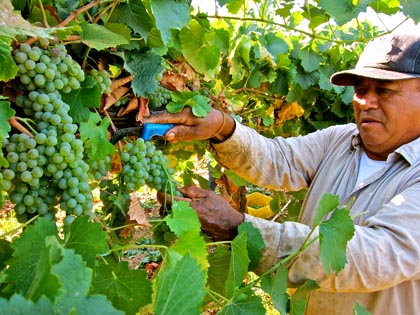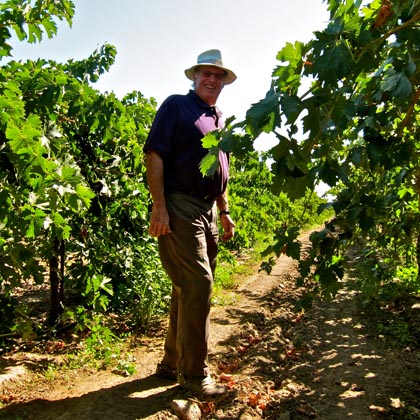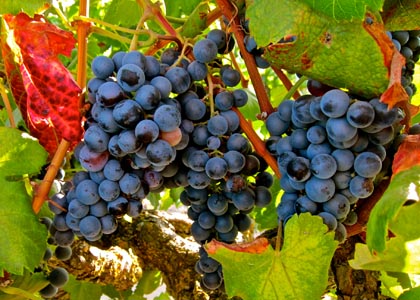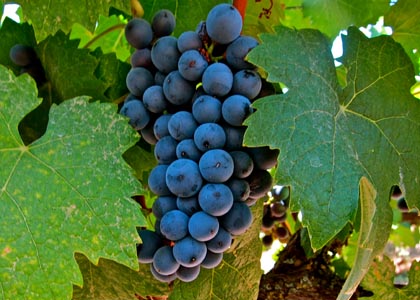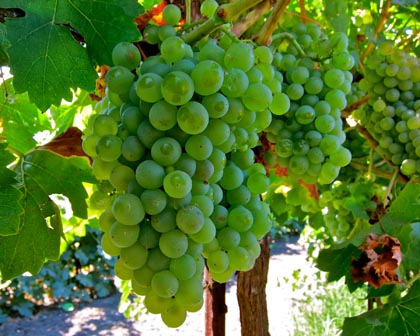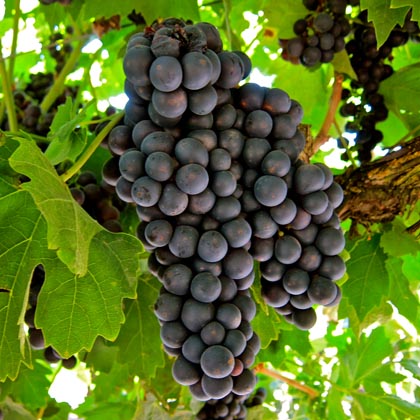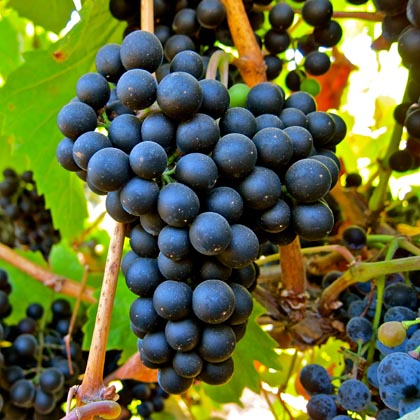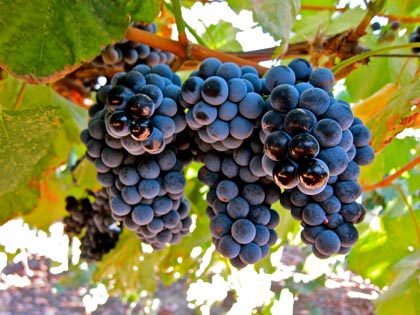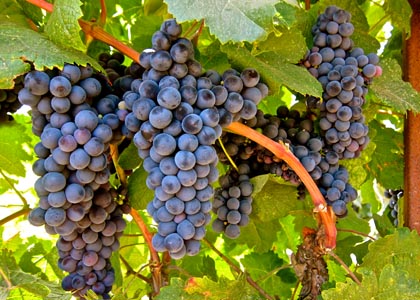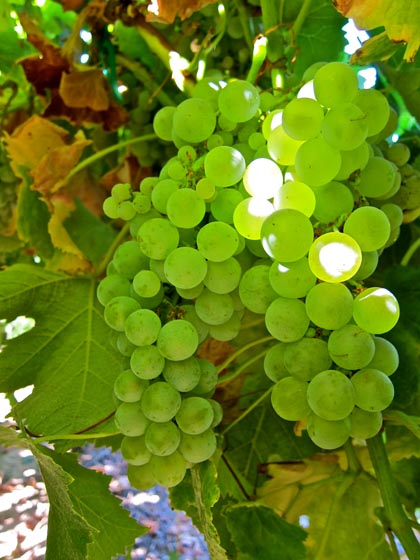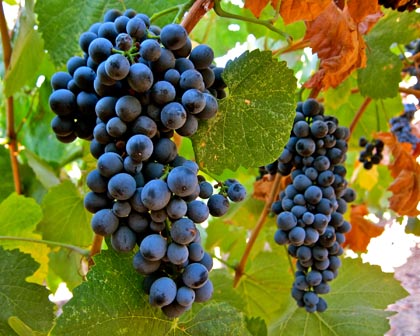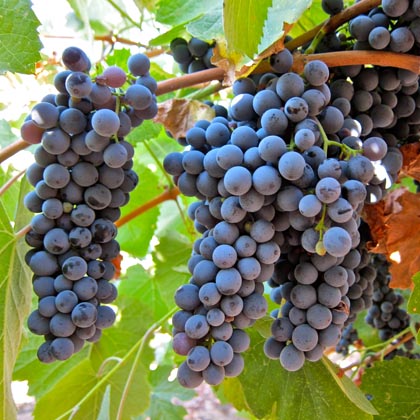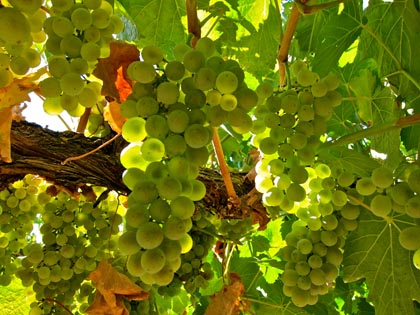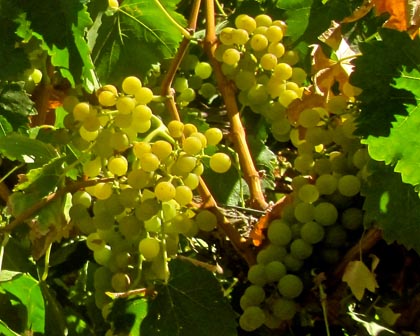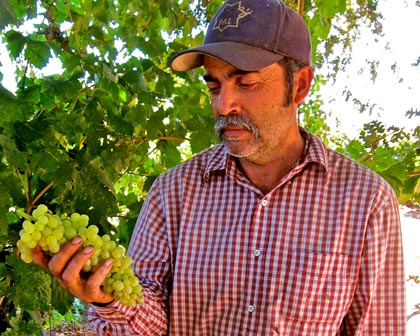Letters from Lodi
An insightful and objective look at viticulture and winemaking from the Lodi
Appellation and the growers and vintners behind these crafts. Told from the
perspective of multi-award winning wine journalist, Randy Caparoso.
Wine’s cutting edge lies in Lodi
2011 harvest of Silvaspoons Vineyards Verdelho
12 Lodi grown grapes that are changing the face of American wine…
I must create a system or be enslaved by another man’s… I will not reason and compare: my business is to create… –William Blake
Rip Ripken in his element: among vines
The grape makes the wine; but of course, so does the imagination and handiwork of the vigneron. Over the past week we have been running from one end of the Lodi AVA to another, taking photographs of all the grapes we find, cultivated in this Sacramento-San Joaquin River Delta influenced region.
Lodi grows a broader range of wine grapes (and more of virtually all of them) than any other region in California, and the U.S. for that matter. Why? Because the variations of rich yet well drained soils and the region’s moderate Mediterranean climate permit it, and because we have the farming culture and heritage that embraces such diversity: if there’s a grape that a vintner might be interested in, Lodi will grow it.
Not to say that Lodi traffics in obscurity. Of most of the world’s best known Vitis vinifera – like Cabernet Sauvignon, Merlot and Chardonnay – Lodi is also California’s largest grower. Lodi’s own wineries are also becoming more significant. Lodi grown and produced wines like Mettler Family Cabernet Sauvignon and Delicato Viognier now go toe to toe with comparable wines produced in other regions of California; winning just as many medals and finding their way onto prestige restaurant wine lists and into retail stores, from Hawai`i to New York. Strong value Lodi grown wines like Michael~David’s 7 Deadly Zins and Peltier Station’s Hybrid Pinot Noir demonstrate one of Lodi’s greatest strengths: the ability to produce $10-$20 wines comparable to the quality of $20-$30 wines grown elsewhere.
But where it gets interesting is in the more exotic varietal niches: wines made from lesser known grapes, appealing to the more curious or adventurous wine lovers of the world. Here are twelve such grapes, in alphabetical order, that Lodi is increasingly becoming known for:
Alicante Bousche; Mohr-Fry Ranches
Alicante Bouschet
Alicante Bouschet – one of the few varieties in the world possessing red colored pulp (the juice of most Vitis vinifera runs clear) – is actually one of Lodi’s heritage red wine grapes: extensively planted and sold in the first half of the last century to supply home winemakers back East. It is actually a vinifera cross (Petit Bouschet x Grenache) developed by a Frenchman named Bouschet in the nineteenth century. There is still substantial acreage of the grape grown in Lodi, and it is favored by wineries within and outside the AVA looking for blenders that can beef up red wines made from grapes like Cabernet Sauvignon and Merlot; although Lodi based wineries like Harmony Wynelands and St. Jorge produce quintessential varietal Alicante Bouschet: extremely aromatic (elderberry and blackberry with Asian spice perfumes), full bodied, round yet substantial feeling in the mouth. Any red wine that is used to bolster Cabernet Sauvignon, after all, is certainly never one to be taken lightly.
Graciano; Bokisch's Las Cerezas Vineyard
Graciano
Among the growing movement towards Spanish style red wines up and down the West Coast, Graciano has emerged as perhaps the biggest surprise: despite having long fallen out of favor in its native region (probably Rioja in Spain), it has become a major component of California reds made primarily from the more famous Tempranillo grape, while also being seen more and more as a varietally labeled wine of its own, especially here in Lodi. And so, today Americans can easily experience something even the Spanish very rarely taste: the moderately full, earthy, spicy (like ginger and cracked pepper) qualities of the Graciano grape, along with its outwardly soft textures, reined in by a typically round yet sinewy core of tannin. Look for the Graciano produced by Bokisch Vineyards; and if you can find them, also the outstanding Lodi grown examples produced by Fenestra in Livermore and Sheldon in Sonoma.
Grenache Blanc; Ripken Vineyards
Grenache Blanc
Lodi grower Richard “Rip” Ripken calls this white wine grape his latest “heart throb,” and critics have been swooning over white wines like Bokisch’s Garnacha Blanca (bottled under the Spanish name for the grape) and the Cochon Grenache Blanc produced by Odisea Wines. This green skinned variant of the black skinned Grenache grape has always maintained a low profile, yet important, presence in vineyards in the north and eastern regions of Spain, and especially in South-West France. Why? Because whether used as a dominant grape or as a blender, it can produce rich, round, supple white wines of remarkable viscosity and flavor (at its best, aromas and flavors suggesting green melon, white peach or apricot, and tropical floral notes). ¡Muy importa!
Primitivo; Ripken Vineyards
Primitivo
Uvaggio winemaker/proprietor Jim Moore recently made an interesting observation: despite the fact that Primitivo is a clonal variant of the Zinfandel grape only recently transplanted (mostly during the past 20 years) from cuttings originating from Southern Italy and Croatia, it’s hard to find imported European bottlings of this varietal red worth a darn. Allowing for the fact that this may be just one man’s opinion (isn’t that true for all passionate wine lovers?), this we know: in recent years, Lodi grown Primitivo has been showing the promise vintners and wine lovers alike have long hoped for in the grape. Harney Lane, for instance, uses as much as 40% Primitivo in its acclaimed Lodi Zinfandel, and both Uvaggio and Ripken have recently been wowing critics, wine competition judges and (most importantly) consumers on a consistent basis with their varietal bottlings of Primitivo. What makes Primitivo so special? Unlike Zinfandel, it has less tendency to grow uneven sized berries; and thus, can produce rich, fairly full flavored reds with the raspberry/cherry/blackberry qualities zin lovers love, but without the high alcohol (i.e. over 14%) and jammy or raisiny excesses typical of Zinfandel. Primitivo as a brighter, gentler, bouncier alternative to varietal Zinfandel is here to stay, and Lodi is emerging as California’s leading source of it.
Petit Verdot; Elk Vineyard
Petit Verdot
Although Malbec and Cabernet Franc are still considered the third and fourth most important red wine grapes originating in France’s Bordeaux region (Cabernet Sauvignon and Merlot being the major ones), here and there we’ve been seeing the signs that suggest that Petit Verdot may one day – perhaps not next week or next year, but not too far from now – supplant the other grapes in significance for this simple reason: the grape grows beautifully in California. Especially in some of Lodi’s better drained, sloping soils, from which wineries like Grands Amis and Michael~David have recently been producing Petit Verdot based reds as varietals or blends that have been everything an aficionado of Bordeaux style wines want in a red wine: a compact, dense yet harmoniously balanced richness, and aromas and flavors oozing both violet scented and raspberry-like fruit. In a word: delicious.
Souzao; Silvaspoons Viineyards
Souzão
In both its native Douro Valley in Portugal and in California, Souzão has long been utilized as one of the grape components going into the sweet, fortified styles of red wine known as Port. Although grapes like Touriga Nacional, Touriga Francesa, Tinta Cão, and Tinta Roriz are considered more important grapes for Port in Portugal, in California Souzão has traditionally played a major role. Very recently a tiny handful vintners have been experimenting with Souzão as a varietal red table wine, with at least one yielding spectacular results: bottled under his R label, Jeff Runquist’s Souzão has been winning numerous awards; as well it should, with its full yet levitating, soft yet zesty, intense yet silken smooth richness, oozing strawberryish fruit and aromatic cake spices.
Tannat; Christesen Vineyard
Tannat
Bonny Doon’s Randall Grahm once likened red wines made from the Tannat grape to a vinous journey into Heart of Darkness. Apropos, because there is a sense of savagery in the super-powered color and tannin this grape is capable of producing in a red wine. Varietal Tannat may not be for the faint of heart, but that doesn’t mean finer bottlings are without a sense of balance, scale or consistency. The Tannat produced by longtime Lodi vigneron David Akin (under his Akin Estates label), for instance, has both rusticity and polish, if such a combination is possible. Woodbridge by Robert Mondavi has been producing red wine combinations utilizing Tannat in various proportions, and Michael~David has also been known to put out some inky rich, muscular reds dominated by this grape of South-West French origins. As Akin once put it, “to be or Tannat to be” – por qué?
Torrontes; Silvaspoons Vineyards
Torrontés
While Torrontés is associated with the light, exotic (musk spice and tropical fruit/flower perfumed), citrusy tart and food-versatile white wines of Argentina (can you say ceviche y mariscos?), its origins are shrouded in somewhat murky history (it was once thought to be the same as the grape also known as Torrontés in Spain, but recent DNA studies are indicating that there is no relationship). Not that it matters. Recently Silvaspoons’ Ron Silva has been successfully growing Torrontés in Lodi’s Alta Mesa AVA; and although production from these plantings has been extremely limited (Fenestra in Livermore, Downhill in Cupertino, and soon, Riaza in Lodi) so far results have been very promising: properly fresh, brightly scented, zesty yet easy drinking dry whites of terrific value and uniqueness.
Touriga Nacional; Silvaspoons Vineyards
Touriga Nacional & Touriga Francesa
These two related black skinned grapes are the two most important grapes of Portugal’s Douro River, going into the famous fortified reds known as Port. They are used accordingly in California by wineries inside and outside the Lodi AVA.
Touriga Francesa; Silvaspoons
In recent years, the two Tourigas have also been producing non-fortified table reds of remarkable richness and dense, meaty textures (look for those of Runquist’s R, Fenestra, and the Lee Family Rio Tinto by Monterey’s Dan Lee). “Touriga,” after all, may soon become famous as the Portuguese answer to Cabernet Sauvignon; just as full blooded, and even more soulful.
Verdelho; Silvaspoons Vineyards
Verdelho
Interest in this white wine grape has exploded in recent years; not in the least due to the skill and determination of Lodi’s own “Portuguese grape king,” Ron Silva (of Silvaspoons Vineyards). Lodi wineries like Riaza, St. Jorge and Alta Mesa (the latter, Silva’s own label) have all been producing white wines that portray the lemony crisp and satin textures for which this grape has long been known, even if somewhat obscurely (i.e. rare examples produced in Europe and South Australia). Other California wineries like Morgan (under the Lee Family label), Santa Cruz Mountain Vineyards (their Quinta Cruz label), and Fenestra have taken full advantage of Silva’s viticultural largesse, all to critical acclaim. There is a movement well afoot, and we strongly recommend joining it.
Vermentino; Delu Vineyards
Vermentino
Uvaggio’s Jim Moore has been on a practically one-man crusade to convert the entire country to the virtues of this Mediterranean grape (commonly grown in Provence, Sardina and Corsica), which he calls the “thinking man’s Pinot Grigio.” Like Pinot Grigio, Vermentino (in Lodi, sourced by Moore in vineyards planted by Kevin Delu) produces medium bodied dry whites with a citrusy crispness. Also like Pinot Grigio, Vermentino yields fragrances that can be likened to lavender and occasionally violet, although Vermentino goes one step further by also exuding pronounced stony or minerally qualities in the nose and flavors, plus a perfume that can also be strikingly of scrubby herbs like wild thyme and rosemary. In other words: an intriguing thinking man’s PG. Look for it, love it… stay thirsty, my friends!
Jessie's Grove vineyard manager, Jose Valencia
